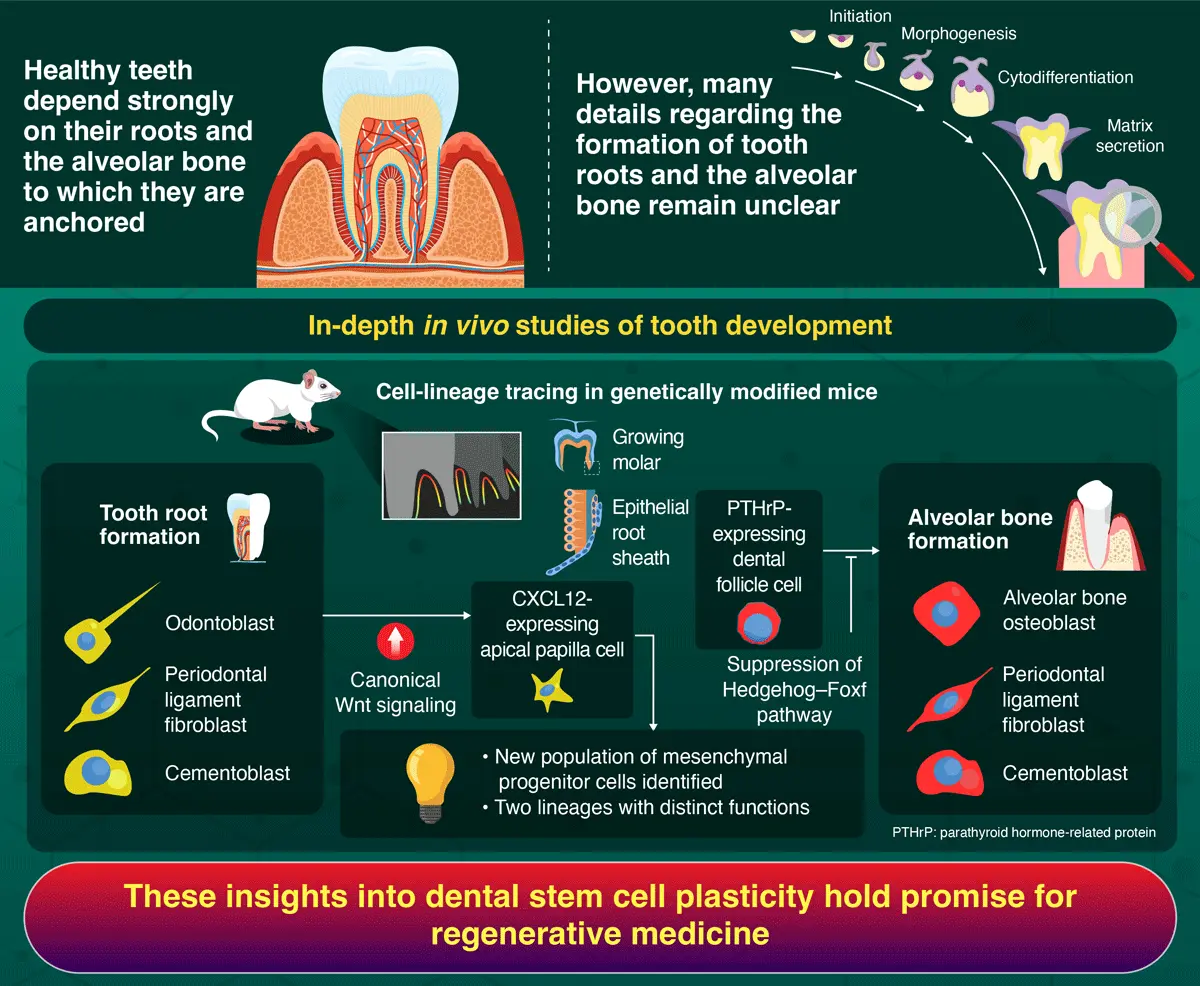Two distinct stem cell lineages that drive tooth root and alveolar bone formation have been identified by researchers from Science Tokyo. Using genetically modified mice and lineage-tracing techniques, the team shed light on the cell signaling mechanisms guiding differentiation in stem cells in the developing teeth, offering key insights for future regenerative dental therapies.
How Dental Stem Cells Differentiate to Form Tooth and Bone

Nagata et al. (2025) | Nature Communications | 10.1038/s41467-025-61048-x
A Hedgehog-Foxf axis coordinates dental follicle-derived alveolar bone formation
Nagata et al. (2025) | Nature Communications | 10.1038/s41467-025-61050-3
The ability to regenerate lost teeth and their surrounding bones is considered a holy grail in the field of dentistry. For decades, the gold standard for replacing a lost tooth has been a foreign object, such as a dental implant or a denture. While these solutions are quite effective, they cannot perfectly replicate a natural tooth's structure, function, or feel. Many researchers are therefore conducting studies on tooth development to open new avenues for regenerative therapies.
However, the process by which teeth and bones develop is incredibly intricate. It involves a dynamic interplay of different cell and tissue types, including the dental pulp, enamel organ, and the bone-forming cells of the jaw, all of which must interact in a precise sequence. These cells communicate through a network of signaling molecules, orchestrating the formation of the tooth's crown, root, and the alveolar bone that anchors it. As one might expect, our understanding of tooth development is far from complete.
To tackle current knowledge gaps, a research team led by Assistant Professor Mizuki Nagata from the Department of Periodontology, Graduate School of Medical and Dental Sciences at Institute of Science Tokyo (Science Tokyo), Japan, and Dr. Wanida Ono of the University of Texas Health Science Center at Houston (UTHealth), USA, in collaboration with the University of Michigan, USA, and other institutions, conducted two studies focusing on the mechanisms guiding stem cell differentiation in growing teeth. Their papers were published as two related papers in Volume 16 of the journal Nature Communications on July 1 and July 2, 2025.
The team used genetically modified mice and advanced lineage-tracing techniques, investigating how cell populations specialize and organize themselves at the 'tip' (apical region) of tooth roots. Through microscopy techniques, fluorescent cellular tags, and gene silencing, the researchers were able to clearly visualize the effects of key signaling proteins on cell fate during tooth development.
In this way, the team identified a previously unrecognized population of mesenchymal stem cells that give rise to two distinct lineages: one strongly associated with tooth root development and the other with alveolar bone formation. The first lineage originates from cells located in the apical papilla within the epithelial root sheath-a cluster of soft tissue at the tip of the growing tooth root. These cells express CXCL12, a protein that plays a key role in bone formation within bone marrow. Through a chemical signaling pathway known as the canonical Wnt pathway, the apical papilla CXCL12-expressing cells can differentiate not only into tooth-forming odontoblasts, but also into cementum-forming cementoblasts at the elongating tooth root and even alveolar bone-forming osteoblasts under regenerative conditions.
The other lineage is concentrated in the dental follicle, a sac-like structure that envelops the developing tooth and contributes to the formation of the surrounding anchoring. The team found that a population of parathyroid hormone-related protein (PTHrP)-expressing cells can differentiate into cementoblasts, ligament fibroblasts, and alveolar bone-forming osteoblasts. Interestingly, the researchers noted that this transformation only occurs under specific circumstances, as Nagata explains: "We observed that the Hedgehog-Foxf pathway needs to be suppressed to drive the alveolar bone osteoblast fate of PTHrP-expressing cells in the dental follicle, unraveling a unique tooth-specific mechanism of bone formation requiring deliberate on-off regulation of Hedgehog signaling."
Together, the findings of these two studies advance our understanding of how teeth and alveolar bone develop in vivo, providing some much-needed clues about their intricate growing mechanisms. "Our findings provide a mechanistic framework for tooth root formation and pave the way for innovative stem-cell-based regenerative therapies for dental pulp, periodontal tissues, and bone," concludes Nagata, with eyes on the future.
These new findings have been published in the journals under the titles "Wnt-directed CXCL12-expressing apical papilla progenitor cells drive tooth root formation" and "A Hedgehog-Foxf axis coordinates dental follicle-derived alveolar bone formation."
Reference
- Authors:
- Mizuki Nagata1,2, Gaurav T. Gadhvi3, Taishi Komori4, Yuki Arai1, Hiroaki Manabe4, Angel Ka Yan Chu3, Ramandeep Kaur5, Meer Ali6, Yuntao Yang6, Chiaki Tsutsumi-Arai4, Yuta Nakai4, Yuki Matsushita7, Nicha Tokavanich1, W. Jim Zheng6, Joshua D. Welch3,8, Noriaki Ono4, and Wanida Ono1,9*
- Title:
- Wnt-directed CXCL12-expressing apical papilla progenitor cells drive tooth root formation
- Journal:
- Nature Communications
- Affiliations:
- 1Department of Orthodontics, University of Texas Health Science Center at Houston School of Dentistry, USA
2Department of Periodontology, Graduate School of Medical and Dental Sciences, Institute of Science Tokyo, Japan
3Department of Computational Medicine and Bioinformatics, University of Michigan, USA
4Department of Diagnostic & Biomedical Sciences, University of Texas Health Science Center at Houston School of Dentistry, USA
5Department of Orthodontics and Pediatric Dentistry, University of Michigan School of Dentistry, USA
6McWilliams School of Biomedical Informatics, University of Texas Health Science Center at Houston, USA
7Department of Cell Biology, Nagasaki University Graduate School of Biomedical Sciences, Japan
8Department of Computer Science and Engineering, University of Michigan, USA
9Present address: Division of Orthodontics, University of California San Francisco School of Dentistry, USA






